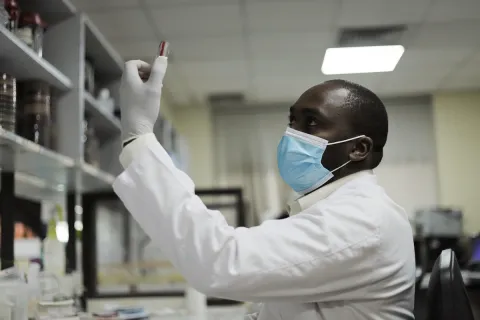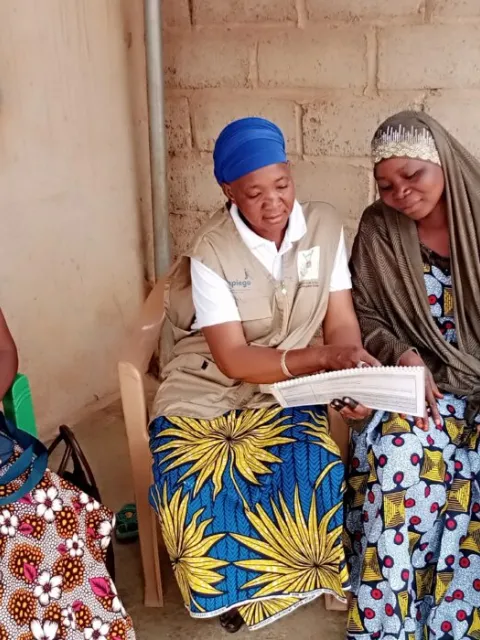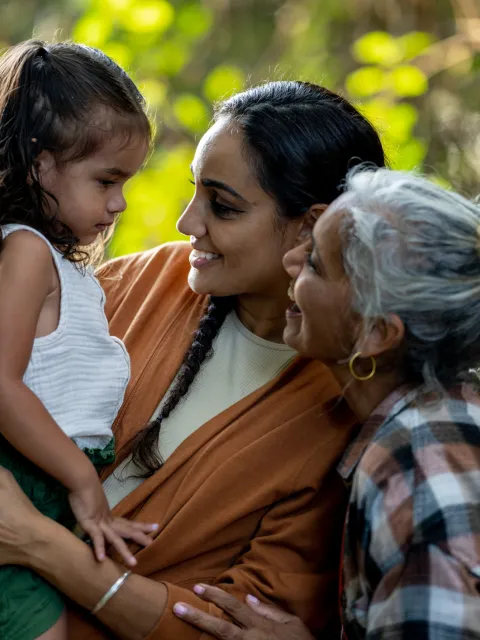How to address the gaps in cancer care in sub-Saharan Africa
UICC Board Member Dr Miriam Mutebi comments on a recent Lancet Oncology Commission report, to which she contributed, and offers responses to the rising cancer incidence and mortality in sub-Saharan Africa.

The number of cancer cases and cancer-related mortality in sub-Saharan Africa has been rising significantly, and is expected to almost double between 2020 and 2040 at current trends. There is now a pressing need to examine the causes and establish a plan of action that will enable countries to tackle this growing burden, so that people living in sub-Saharan Africa have the best opportunity to prevent or survive cancer.
In early May, The Lancet Oncology published a Commission report on “Cancer in sub-Saharan Africa”, which issued eight urgent calls to action based on an in-depth assessment of the cancer burden in the region. The report noted the significant gaps that need to be filled, as well as how to build on progress to date. It also highlighted the opportunities that can be seized to reduce inequities in care and improve the lives and health of those living in sub-Saharan Africa.
The first essential action recommended by the Commission is for countries to develop or update national cancer control plans and implement or expand universal health coverage (UHC) to include cancer care and ensure equitable access to health services. They should also include routine screening and early detection programmes for relevant and prevalent cancers (e.g. cervical, breast, colorectal, prostate) when efficient treatment for these cancers is available.
Furthermore, cancer plans should set up a sustainable access to and availability of medicines, and encompass how to manage cancer and other diseases such as HIV and malnutrition that exacerbate the risk of disease and undermine survival.
The Commission also emphasises the need for reliable data and therefore the need to improve data acquisition, investing in cancer registries and diagnostics, Finally, countries need to build and maintain a skilled workforce and invest in innovation and research, as well as telehealth and other approaches that were used effectively during COVID-19 to improve access to information and services.
UICC spoke with one of the commissioners and authors of the report, Dr Miriam Mutebi, UICC Board Member, President-elect of AORTIC (African Organisation for Research and Training in Cancer) and Assistant Professor in Surgery at the Aga Khan University in Kenya, for more details on what countries in the region can do to reduce their cancer burden.
What prompted a Lancet Commission on cancer in sub-Saharan Africa?
The Commission started just before COVID-19 and the work was long overdue. There is a new movement in global oncology that recognises the need to decolonise global health to better address issues of justice and equity in health. This means in essence developing approaches that involve local actors and reflect local resources, settings and solutions.
The Lancet Oncology Commission therefore set out to develop a framework that would bring together the currently fragmented responses to the cancer situation, draw on lessons learned, lay out best practices and examine opportunities for different stakeholders to collaborate and improve care.
What is driving the increase in the number of cancer cases and cancer-related deaths?
There are a number of external and internal factors, including demographic and lifestyle changes – inactivity, processed foods, alcohol and tobacco, obesity – and well as environmental exposures and genetics. Infectious disease factors also cause about 27% of all cancers in the region: HPV and cervical cancer, hepatitis B and C and liver cancer, HIV and Kaposi's sarcoma.
For a long time, the priority in health in sub-Saharan Africa has been infectious diseases, they have been the big driver in terms of funding. We are seeing now an emerging pandemic around non-communicable diseases such as cancer and cardiovascular disease, and as there are frequent intersections, we must leverage existing infrastructure and outreach programmes for communicable diseases and apply them to cancer care where possible.
What are the main gaps in care that need to be addressed?
The most prevalent cancers in Africa are breast, cervical, prostate, gastrointestinal and Kaposi sarcoma in regions with high HIV. Overall, we see a preponderance of female cancers but this may also be due to a lack of reliable data and reporting. This does have real implications, however, because women tend to be quite vulnerable in terms of access – they are often not the ones making choices about their health.
One of the first investments that needs to be made is in data collection. Many countries don’t have national registries, or only small population-based registries that are not always reflective of the national burden. There have been attempts by the International Agency for Research on Cancer and local stakeholders to improve on this, which has led to the creation of the African Cancer Registry Network. This provides shared learning, mentorship and support for registries on the continent.
The barriers to maintaining robust registries in Africa are nuanced. Then lack of data also highlights a lack of diagnostics capacity. One frequently requires a tissue diagnosis to input data into a cancer registry. However, many patients are diagnosed clinically at advanced stages of their cancer, but frequently lack an accompanying histological diagnosis. It is important to increase access to and training in pathology services and workforce and to boost local training in forensic diagnoses, in order to improve and support cancer registries.
Finally, cancer needs to be made a notifiable or reportable disease. In Kenya for instance, due to efforts from the local cancer control programme, cancer was declared a notifiable illness last year. Prior to this, similar to many countries in Africa, only communicable diseases such as tuberculosis were traditionally reported to government authorities. Reporting and strengthening registries will help to provide insights into the true burden of disease, which will aid in planning interventions and investments.
You mentioned that cancers are often diagnosed late, when they are harder to treat. This contributes to lower survival rates. Screening and early detection would also therefore seem to be significant challenges. How can they be improved?
First, we need to raise awareness, not only among the general public but also among frontline workers, about the importance of screening and early detection for certain cancers at certain ages. It is also important to educate health workers about the early signs and symptoms of cancer.
While the actual services for screening and early detection need to be available, it is equally essential to ensure that appropriate referral pathways and treatment facilities exist for diagnosed patients. Otherwise, people will be left with the knowledge that they have cancer and that nothing can be done about it. This perpetuates cancer fatalism and the idea that cancer is a death sentence will likely become even more entrenched. The net result is that populations will be even less likely to go in for screening!
Finally, expense is a major factor. A few countries in sub-Saharan Africa have developed national health insurance schemes that mitigate some of the costs of treatment. However, these frequently do not cover screening, so people would be largely paying out of pocket. There is a clear need to develop national comprehensive prevention approaches for NCDs that cover relevant screening where appropriate.
What are some other significant challenges to improving cancer services in sub-Saharan Africa?
The health workforce remains a considerable barrier. Often countries may have the infrastructure or machines but lack skilled staff. The digital transformation of the past few years has opened up a host of opportunities to allow patients and caregivers access to specialised care. Telehealth, telepathology and teleradiology allow for a technician to run tests, such as a radiographer conducting a mammogram, while the medical doctor interpreting the data, in this case the radiologist, doesn’t have to be on site to provide the diagnosis. I have often said, however, that technology is not panacea for dysfunctional health systems. A top priority for countries in the region must therefore be to strengthen the health infrastructure and ensure a skilled workforce.
There are also social and cultural barriers, such as stigma and ‘cancer fatalism’. People don’t see the point in seeking medical advice or help, if they don’t believe cancer can be treated. They sometimes view screening as looking for trouble or wishing bad karma on one’s self. Another important social barrier is the fact that, in many settings, women are often not in a position to make decisions about their health as they frequently require financial support and sometimes permission to access services. Even when it comes to reproductive cancers, key decisions are frequently made by men who decide for them – a father, a brother, a husband or by the community (collectivism).
To break down these barriers, the issue must be framed in terms of health equity, fair access to services, not as a “woman’s problem” but as a community problem. And we need to engage all community and religious leaders and stakeholders, who play an important role as ‘gatekeepers’ in ensuring that women access the care they need. Cancer survivors and grassroots advocacy groups also play an essential role in breaking down misconceptions and taboos around cancer, by sharing their experiences and infusing hope into the cancer narrative.
And what can be done at the health systems level?
We need strategies that incorporate an integrated approach to care – in other words, we need to treat patients, not diseases! For instance, we see HIV patients, who come to a hospital every month for treatment, diagnosed with stage IV cancers. This shouldn’t happen: They should and can be screened and checked regularly by clinicians.
At the same time, we need to ensure that these routine exams can be set up without overloading healthcare providers who are already managing a heavy caseload. Integration can be complex, but it is feasible and certainly a more resource-efficient means to screen and detect cancers early than by setting up completely separate programmes.
What about the issue of access to medicines? Some people are dying of a disease because the medicines that could successfully treat them are not available – how can this situation change?
We have two major concerns regarding essential cancer medicines. Access itself is a challenge: a patient in sub-Saharan Africa pays on average four times more than in low- and middle-income countries in general, primarily due to the lower demand from individual countries, which means they are purchasing smaller quantities at higher costs. Therefore, we have a situation where the countries with fewest resources are paying the most for drugs.
The second major concern is the lack of regulation and quality control of medications, so a lot of generics may be false or substandard. This issue was also highlighted in a Comment on our report also published in The Lancet Oncology[1]. Also, many chemotherapy medicines, as well as antibiotics, can be bought over the counter, which means that there is a high potential of misuse. This problem is only the tip of the iceberg and the solutions are complex, requiring a multifaceted, partnership response to ensure adequate staffing and training, pooled procurement for financing, and pooled resources for monitoring and regulation, for instance with a network of onco-pharmacists. The ATOM Coalition launched in May by UICC was precisely designed to offer solutions to this complex issue of access to medicines.
The report by The Lancet Oncology Commission issues some very clear and concrete calls to action. What would you highlight in particular?
Definitely investing in workforce, along the entire health and cancer continuum. Any plans – to improve treatment, data collection, registries or access to medicines – have as a common denominator, training and staffing.
The resources to expand the health workforce are available and it can be done with sufficient political will. We know that countries that have in-country training and programmes tend to see an improvement in universal access to care. They are also less likely to have issues of staff retention, so called “brain drain”, if one develops in-country training and builds capacity on the ground based on the existing gaps.
In addition to in-person training, countries should explore how they can tap into existing diaspora. A lot of specialists around the world are from sub-Saharan Africa – how do we get them to lend their expertise locally? The pandemic has offered opportunities through digital innovations, to collaborate with and expand the reach of the global workforce for cancer. These are developments which should continue to be leveraged going forward!
Finally, looking to the future, we need to look at building centres of excellence, offering a platform for the exchange of knowledge and expertise in research, clinical resources, diagnostics and treatment capacities across the continent. There is now a critical mass of dedicated workforce along the cancer continuum in Africa. Intentional collaborations have the potential to stem the emerging crisis. The time to act in now!
_______________________________________
[1] “Cancer in sub-Saharan Africa: key research and action gaps" in The Lancet Oncology (June 2022) by Sonali Elizabeth Johnson, Head of Advocacy and Knowledge, UICC; Fanny Bauer, Manager, Capacity Building, UICC; Lara Abdelmunim Idris, Head of Radiation Oncology, Radiation And Isotope Centre Khartoum.
Last update
Wednesday 03 August 2022
